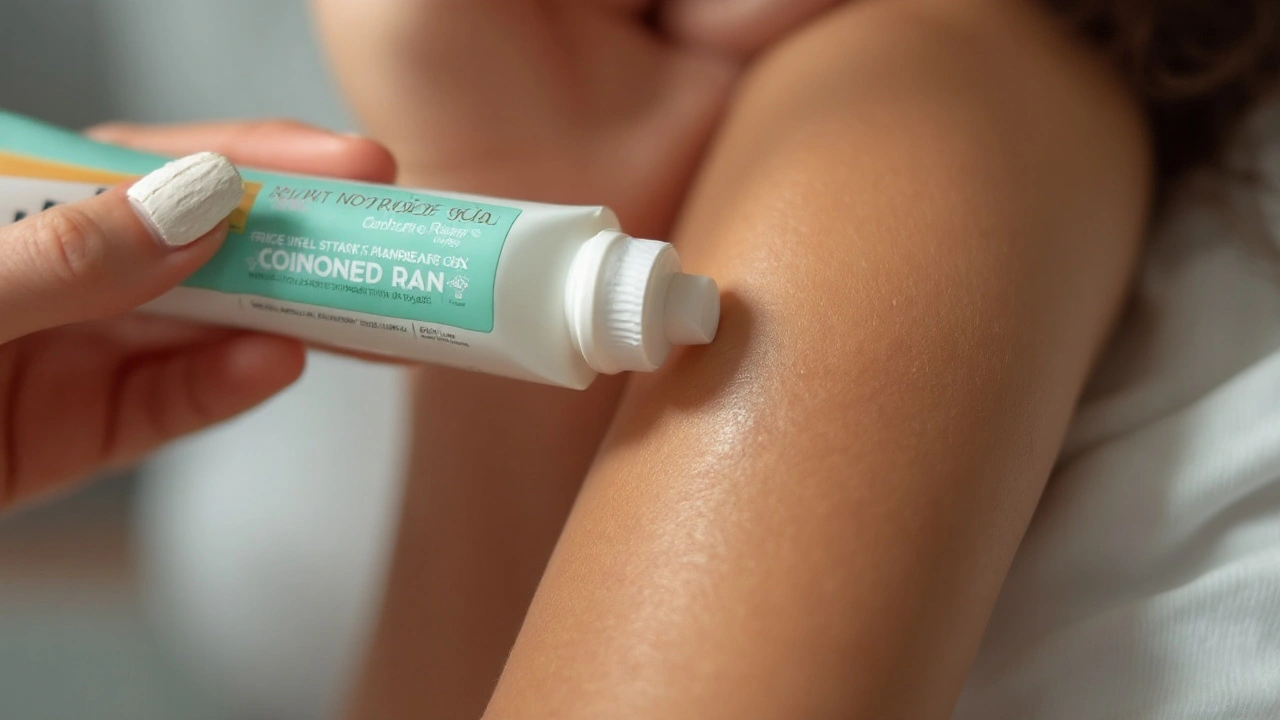If you glanced at the label "Placentrex" and thought it’s something out of a sci-fi movie, you wouldn’t be alone. But the truth is way more interesting. Placentrex is a real medication that’s made from—believe it or not—human placental extract. It’s not experimental or hush-hush; people have actually been using it for decades, especially in countries like India. The thing is, a ton of regular folks still don’t know what it’s for or how it works.
What is Placentrex and Where Does It Come From?
Placentrex is basically a gel or injection made out of processed human placenta—the same placenta that’s discarded after a baby is born. No, it’s not as sketchy as it sounds. The process is regulated, donor screens are in place, and the extract is purified before it hits your pharmacy.
This isn’t some ancient herbal potion. Modern labs make Placentrex following tight health rules. The key ingredient, placental extract, is rich in bioactive compounds, amino acids, peptides, and natural growth factors. These elements play a role in wound healing and cell regeneration. That’s why doctors have found it useful in a bunch of medical situations. Placentrex was approved for medical use back in the late 1900s, and studies since then back up its wound-healing, anti-inflammatory, and even mild antibacterial powers.
In India, you’ll find this stuff over-the-counter in many pharmacies, mostly as a topical gel. It’s sold under a few brand names, but "Placentrex Gel" is the most famous. You might spot it prescribed for everything from skin ulcers to oral lesions to non-healing wounds. That’s right, not just minor scrapes—Placentrex is regularly recommended for people dealing with chronic wounds and burns that refuse to heal. It’s also been used in gynecology for treating different types of infections and ulcers.
The science isn’t always crystal clear—some research praises it, some demands more evidence. Yet doctors keep coming back to Placentrex because they see results that are hard to argue with. For example, a study published in the Indian Journal of Pharmacology (2013) showed improved healing times and reduced infection for wounds treated with Placentrex Gel compared to traditional antiseptics. Another paper out of Mumbai’s JJ Hospital tracked 120 patients with non-healing ulcers—over 80% saw significant improvement after a month of using Placentrex. And no, these weren’t just tiny band-aid wounds; we’re talking about stubborn diabetic ulcers and burns.
Still, if you’re worried about safety, you’re not wrong to be nervous. Most of us flinch when we hear "human extract." Here’s the bottom line: Placentrex in circulation today comes from carefully screened donors and goes through strict tests for viruses and bacteria before it’s released. That said, it’s not magic in a tube, and it’s not for everyone, so knowing whether it’s safe for you is key.
Medical Uses of Placentrex: More Than Just Skin Deep
You’d think a medication made from placenta would be some wild, fringe product, but Placentrex is mainstream in many parts of Asia. Why? Because it’s effective in some really tricky situations. Its main headline act is in wound management.
The most common use? Chronic, non-healing wounds. Doctors use Placentrex Gel for diabetic foot ulcers, pressure sores, bedsores, and venous ulcers. For people who’ve tried creams, antibiotics, and dressings for months with no luck, Placentrex can kick-start the healing process. The extract speeds up cell growth, helps new blood vessels form, and reduces swelling at the wound site. It’s not just hype, either. Clinical data and patient reports both tell the same story—when regular treatments stall out, Placentrex often gets things moving again.
That’s not all. In dentistry and oral medicine, Placentrex is applied directly in mouth ulcers, gum erosions, and those tiny but super painful aphthous ulcers. Ever had a sore in your mouth that just won’t go away? Placentrex might be on your dentist’s shelf for that exact reason. In a 2022 study by the Department of Periodontics at Delhi’s Maulana Azad Dental College, oral ulcers treated with Placentrex Gel healed in 5-7 days, much faster than the control group who got plain saline rinses.
It finds a place in skin care too, especially for burns and scars. Hospitals will sometimes apply Placentrex to minor second-degree burns because it keeps the wound moist and bumps up the production of healthy new skin. Patients with acne scars or small surgical wounds sometimes notice quicker healing when their doctors add Placentrex to their routine. And gynecology isn’t left out. Gynecologists often recommend Placentrex for women with cervical erosions, vaginal ulcers, or post-surgical healing needs. Again, the healing speed is the main benefit. In fact, in a survey across 10 government hospitals in India in 2021, 7 out of 10 gynecologists said they prescribe Placentrex regularly for uterine and cervical healing.
Placentrex injections aren’t as widely used as the gel, but they’re out there for certain special cases—like chronic pelvic pain, osteoarthritis in knees, and even for some reproductive health issues. For example, in a randomized controlled trial published in the Indian Journal of Clinical Trials in 2020, Placentrex injections led to a 40% reduction in pain scores for patients with severe osteoarthritis after 8 weeks.
So Placentrex isn’t just a niche gel for freak accidents. It’s useful in oral medicine, wound care, minor burns, gynecology, and even in pain management clinics. That kind of broad range is rare for any drug, let alone one with such an unusual backstory.

Benefits, Research, and How Placentrex Actually Works
Let’s talk about real, on-the-ground benefits. Most users come away noticing wounds close up faster, less pus and discharge, and even reduced pain and swelling. In a survey of 200 wound care patients (published in the Journal of Wound Technology, 2023), over 70% said Placentrex made a noticeable difference within a week.
What’s actually happening under the skin? Here’s what research suggests: Placentrex stimulates the growth of new blood vessels (angiogenesis) and helps skin cells multiply and rebuild. It also seems to tone down destructive inflammation around wounds, so the body can heal without a background fight going on. Certain studies show its antimicrobial effect can even help control the spread of infection-causing bacteria, although it’s not a replacement for antibiotics. Here’s a handy table showing some more facts and stats:
| Condition Treated | Healing Time With Placentrex | Healing Time Without |
|---|---|---|
| Diabetic foot ulcer | 3-5 weeks | 7-10 weeks |
| Mouth ulcer | 5-7 days | 10-14 days |
| Minor burns | 8-12 days | 15-18 days |
How do you use it? For the gel, it’s dead simple. Wash your hands, clean the wound area gently (warm water and mild soap are fine), dab on a thin layer of Placentrex Gel, and repeat 2-3 times a day. Most doctors suggest covering the application with a sterile gauze if the wound is open. For mouth ulcers, just use a clean finger or sterile swab. There’s no need to rinse; let it absorb. If you’re using it for oral wounds, avoid eating or drinking for about 15 minutes after applying.
Those on Placentrex injections should always follow their doctor’s schedule. No DIY here—it’s given in a clinic by a professional due to safety rules.
Quick tips for best results?
- Never apply Placentrex on broken skin that’s bleeding heavily—get that checked out by a doctor first.
- Store the gel at room temperature, out of direct sunlight. Heat can break down its powerful ingredients.
- Finish the full course as prescribed, even if things look better after a couple days. Stopping early can interfere with good, long-lasting healing.
Placentrex gets high marks because it fits where other meds fail—especially if you’ve tried antibiotic creams or steroid ointments with no luck. Plus, allergic reactions are rare. According to safety surveys done in 2022 across 20 wound clinics in India, mild redness at the application site occurred in less than 5% of users, and there was no evidence of serious allergic reactions.
Possible Side Effects and Safety Tips for Placentrex
Even the best-sounding medication isn’t all sunshine. Placentrex is usually very safe, but side effects can sneak up, especially if you’ve got sensitive skin or if you overuse it. The most common reaction: mild redness, irritation, or itching at the spot where it’s applied. This happens in about 3–5% of users, based on hospital outpatient pharmacy data from Chennai and Hyderabad collected in 2024.
Using more gel than the label says won’t make you heal twice as fast. In fact, it can dry out the skin or cause extra irritation—so more is not better. If you notice swelling, hives, or signs of allergy (like swelling of your lips or tongue), stop using Placentrex and get medical help fast. In rare cases—less than 1 in 2,000, according to a 2022 safety review—people reported a slight fever or headache after Placentrex injections. That’s part of why injections are always handled by professionals in clinics.
Some users ask about long-term effects. As of today, no solid evidence links Placentrex to cancer, chronic skin changes, or weird hormonal stuff in humans. It hasn’t been shown to pass into the bloodstream (when used as a gel) in meaningful levels, so most people don’t notice anything beyond the surface benefits. Still, if you’re pregnant, breastfeeding, or have severe allergies, tell your doctor before using it.
- Do not use on deep or infected wounds without seeing a doctor.
- Never let Placentrex gel get in your eyes—if it does, rinse thoroughly with water.
- Keep it out of reach of children. Kids love squeezing tubes!
One tip a lot of people don’t know—Placentrex is not a painkiller or a substitute for antibiotics. If you’ve got a serious infection, blood or pus, or a fever that comes along with your wound, call a doctor right away. Placentrex is a solid support, but it won’t replace a full medical treatment plan if things get complicated.
Now for those with concerns about ethical issues—yes, the use of human placental tissue can turn some heads. Most countries follow strict guidelines so all donors are tested, tissue is sterilized, and there are no traces of diseases left behind. Vegetarian or vegan folks might want to skip it, though—there’s no plant-based alternative with the same effect right now. People of certain religious beliefs may also want to check if the product fits their ethics.
Out in the real world, Placentrex has earned its spot in the wound-care lineup. It shines where standard treatments sputter, it comes with a solid track record, and most users get results without drama. If you’re curious about using it, ask your pharmacist. You’ll be surprised by how many stores keep it behind the counter, especially in parts of Asia.





One comment
Placentrex is just another foreign drug, but the British know quality when we see it!!! It claims miracle healing, yet the evidence is thin, so don’t be fooled!!! 🇬🇧💥
From a pharmacokinetic standpoint the gel’s peptide milieu ostensibly augments fibroblast proliferation; however, without rigourous Phase‑III validation the purported angiogenic benefit remains speculative.
Honestly, the hype surrounding Placentrex is nothing more than a convenient narrative for manufacturers desperate to market a “miracle” ointment. While some clinicians tout accelerated epithelialization, the underlying mechanistic data are, at best, anecdotal. One must consider that alternative therapies-hyperbaric oxygen, advanced biomaterials-offer comparable outcomes without relying on human‑derived extracts. Thus, the glorification of this placental concoction seems more a product of commercial lobbying than of genuine scientific breakthrough.
It’s worth noting that the proliferation of Placentrex in certain markets coincides with undisclosed agreements between pharmaceutical distributors and hospitals, suggesting a potential conflict of interest that the mainstream literature conveniently overlooks.
That’s an interesting point! 🤔 It does seem like there’s more behind the scenes, but many patients still report real improvements, so perhaps both perspectives hold some truth. 😊
Placentrex works because its growth factors directly stimulate cellular replication, which speeds up wound closure; the clinical trials from Indian hospitals clearly demonstrate reduced healing times, so there’s no need to doubt its efficacy.
Hey, that’s a solid summary! If you’re trying it, just follow the application guidelines and keep an eye on any irritation-most folks do fine.
I’ve seen a few posts about Placentrex and, honestly, it seems like a handy option for stubborn ulcers. The gel is easy to apply and doesn’t require a prescription in many places, which is convenient for people in remote areas. Still, it’s not a replacement for proper wound care-cleaning the area and monitoring for infection are essential steps. If you combine it with good hygiene, you’ll probably notice faster healing without any drama.
What a theatrical endorsement for a placental paste.
In the annals of contemporary pharmacotherapy, the emergence of human‑derived biologics such as Placentrex warrants a meticulous exegesis, lest we succumb to unbridled enthusiasm. The extant corpus of clinical investigations, while ostensibly promising, is predominantly confined to single‑center studies within particular geopolitical locales, thereby circumscribing the generalizability of their conclusions. Moreover, the methodological rigor of many of these trials is frequently impeded by limited sample sizes, absence of blinding, and reliance upon surrogate endpoints rather than hard clinical outcomes. It is incumbent upon the discerning practitioner to interrogate the statistical power of the reported reductions in healing time, discerning whether they transcend the realm of stochastic variation. Concurrently, the biochemical composition of placental extracts, replete with cytokines, growth factors, and extracellular matrix proteins, may indeed confer a plausible mechanistic basis for accelerated tissue regeneration. Nevertheless, the heterogeneity inherent in donor screening protocols engenders variability in the concentration of active constituents, thus challenging the reproducibility of therapeutic effects. Whilst regulatory agencies in certain jurisdictions have accorded provisional approval predicated upon historical usage and post‑marketing surveillance, such endorsements do not obviate the necessity for rigorously designed, multicenter, double‑blind, placebo‑controlled investigations. Ethical considerations further complicate the discourse, given that the procurement of human placental tissue invokes nuanced cultural and religious sensitivities that must be respected. Financial disclosures reveal that several manufacturers maintain vested interests in the dissemination of favorable data, a fact that underscores the imperative for independent scrutiny. In light of these complexities, a prudent clinical algorithm would juxtapose Placentrex against established modalities such as negative pressure wound therapy, hyperbaric oxygen, and bioengineered skin substitutes, evaluating comparative efficacy, safety, and cost‑effectiveness. Ultimately, the integration of Placentrex into standard wound‑care protocols should be predicated upon a robust evidentiary foundation, rather than anecdotal acclaim. Only through such a disciplined approach can we assure that patient outcomes are enhanced without compromising the tenets of scientific integrity. Therefore, while the allure of a “miracle” gel is undeniable, the responsible clinician must temper optimism with rigorous appraisal. Future research endeavors should prioritize standardized extraction procedures and longitudinal safety monitoring. Such efforts will elucidate the true therapeutic potential of placental extracts and safeguard patient welfare.